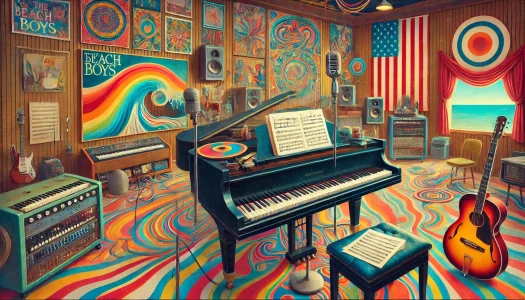In the mid-1960s, Brian Wilson set out to create what he envisioned as The Beach Boys’ magnum opus—a record that would surpass anything the band or their contemporaries had ever done. Titled Smile, the album was meant to be a “teenage symphony to God,” blending intricate harmonies, unconventional arrangements, and ambitious lyrical themes that would expand the boundaries of pop music.
Smile aimed to capture the essence of American life and spirituality through a sonic landscape that fused innocence with avant-garde experimentation. However, plagued by creative pressures, mental health struggles, and internal band tensions, Wilson never completed the album as originally intended. By 1967, Smile was shelved, leaving only fragments of its bold vision for fans and musicians to uncover.
Background: The Vision Behind “Smile”

In 1966, fresh off the critical acclaim of Pet Sounds, Brian Wilson found himself on a creative high, driven by a desire to push the boundaries of pop music far beyond its commercial roots. Pet Sounds had already showcased his ability to blend lush, orchestral arrangements with deeply introspective lyrics, setting a new standard for what pop albums could achieve. But Wilson wanted more—something grander and more conceptually profound. With Smile, he set out to create what he called a “teenage symphony to God,” a work that would explore themes of innocence, spirituality, and the American experience in a way that defied the typical three-minute song structure and formulaic pop arrangements of the day.
Inspired by the experimental energy of the 1960s, Wilson envisioned Smile as a sprawling, multi-part suite that would elevate pop music into an art form. He teamed up with lyricist Van Dyke Parks, whose surrealist, Americana-infused lyrics matched Wilson’s vision of an album that would capture both the beauty and complexity of life in America. Drawing from diverse influences—baroque classical music, folk, jazz, and psychedelic sounds—Wilson planned to craft a collage of interlocking musical fragments that would feel cinematic, like a sonic journey across the American landscape.
However, this ambitious vision came with enormous creative pressure. Wilson’s commitment to artistic experimentation was relentless, and he began employing a modular recording approach, capturing isolated sections of music that would later be stitched together to form a cohesive whole. This radical approach, however, introduced both technical and mental strain, creating an atmosphere of intense, almost obsessive pursuit in the studio. As the sessions went on, Smile became less about creating hit songs and more about exploring the outer edges of what pop music could express.
Creative Process: The Making and Unmaking of “Smile”
The recording sessions for Smile were like nothing The Beach Boys had ever undertaken. For Brian Wilson, the album wasn’t just a collection of songs; it was an ambitious project that demanded a whole new approach to music-making. Rather than recording each track as a linear piece, Wilson employed a groundbreaking technique he called “modular recording,” where individual sections were recorded separately and later pieced together. This gave him the flexibility to layer sounds, experiment with timing, and create an intricate, non-linear tapestry of music. Each segment could stand alone as a unique musical idea, but together, Wilson hoped they would form an unprecedented sonic journey.
Working alongside lyricist Van Dyke Parks, Wilson crafted songs that leaned into surrealism and American mythology, weaving complex lyrics with unusual chord progressions and shifting time signatures. Parks’ playful yet cryptic wordplay on tracks like “Heroes and Villains” added depth to Wilson’s kaleidoscopic vision, giving the album a sense of Americana that felt both nostalgic and forward-looking. In the studio, Wilson’s quest for innovative sounds was relentless.
Unconventional Instruments
He incorporated unconventional instruments like harpsichords, bass harmonicas, bicycle bells, and even elements as unexpected as dogs barking and the sound of fire. The layered, multi-part harmonies that The Beach Boys were famous for reached new heights on Smile, with Wilson pushing his bandmates to stretch their vocal abilities in intricate, overlapping parts that required hours of meticulous rehearsal.
But the creative freedom Wilson demanded came at a high cost. As Smile sessions dragged on, Wilson’s mental health began to deteriorate. The pressure to outdo Pet Sounds, combined with mounting expectations from Capitol Records for a commercially viable album, weighed heavily on him. Rumors of competitiveness with The Beatles—who were themselves pushing musical boundaries with Sgt. Pepper’s—added to Wilson’s self-imposed burden to deliver a masterpiece. At the same time, the other members of The Beach Boys struggled to connect with Wilson’s vision, finding the abstract lyrics and disjointed recording process at odds with their traditional pop roots.
Themes and Motifs: The Heart of “Smile”
At its core, Smile is a vivid exploration of America’s cultural and spiritual landscape, filtered through Brian Wilson’s experimental imagination. One of the album’s central themes is Americana—a journey across the country’s historical and mythological heart. Tracks like “Heroes and Villains” present an almost cinematic vision of the American West, with lyrics that allude to old frontier tales and the country’s folklore. Wilson and Van Dyke Parks created these themes as playful yet profound snapshots of American ideals and struggles, blending nostalgia with a sense of surrealism. Parks’ lyrics evoke iconic American imagery while leaving room for interpretation, making Smile a symbolic look at the country through a fractured, whimsical lens.
Spirituality
Spirituality is another key motif, with Wilson’s “teenage symphony to God” aiming to capture a sense of innocence and wonder. Tracks like “Our Prayer” exemplify this, with the opening harmonies resembling a choral invocation—a wordless hymn meant to set a sacred tone for the album. This spiritual undercurrent runs through much of Smile, with moments of quiet introspection counterbalanced by bursts of joy and playfulness. The album swings from the divine to the absurd, balancing a reverence for beauty with quirky, unexpected elements.
Humor also plays a central role in Smile, lightening the album’s weighty themes and adding a sense of irreverence. “Vega-Tables,” for instance, turns everyday subjects into playful musical vignettes, celebrating the ordinary while inviting listeners to see familiar things in fresh, surprising ways. Wilson’s interest in sounds that defy conventional expectations is evident here, with quirky effects like chomping sounds and chants that blend into the song’s rhythm.
“Good Vibrations,” originally conceived as part of the Smile project, embodies the album’s complexity and ambition. Built from individual sections that shift in mood and texture, the track feels like a musical collage—each piece distinct yet seamlessly linked. It’s a testament to Wilson’s visionary modular approach, with lush harmonies, ethereal theremin lines, and layers of sound that merge to create a sensory, almost transcendent experience. This track, along with “Heroes and Villains,” showcases Smile’s dual nature: a tapestry of complex compositions rooted in both playful and profound ideas, inviting listeners into Wilson’s rich and experimental world.
The 2004 Resurfacing and The “Smile Sessions”
Nearly four decades after the Smile sessions were abandoned, Brian Wilson revisited his “lost masterpiece” with a fresh perspective. In 2004, he released Brian Wilson Presents Smile, a reimagined version of the album, now structured as a solo project. Working with his longtime collaborator Darian Sahanaja and his touring band, Wilson reassembled the musical fragments and unfinished compositions into a cohesive whole. For the first time, audiences were able to experience Smile as a completed album, brought to life through Wilson’s renewed vision and updated arrangements. This version streamlined the original’s more abstract ideas, bringing clarity to its structure and highlighting its thematic flow from Americana to spirituality.
The Smile Sessions
While Brian Wilson Presents Smile was warmly received, with critics praising Wilson for completing what many had deemed “unfinishable,” it was clear that this was a modern interpretation, not the Smile that had haunted fans’ imaginations since the 1960s. In 2011, The Smile Sessions was released, offering listeners an unprecedented look at the original recordings from 1966-67. This compilation was less a finished album and more a curated set of studio sessions, including fragments, alternate takes, and mixes that allowed listeners to glimpse Wilson’s raw creative process.
The Smile Sessions aimed to reconstruct the original Smile as closely as possible, preserving the fragmented beauty of Wilson’s initial vision. Listening to it felt like entering Wilson’s chaotic, ambitious world as it had been left in the 1960s—open-ended, mysterious, and full of promise.
The 2004 solo version and the 2011 sessions each shed light on different aspects of Smile. The 2004 release had the benefit of hindsight, condensing Wilson’s ideas into a clearer narrative structure, while the 2011 sessions gave listeners a taste of the album’s potential complexity and spontaneity. The Smile Sessions in particular garnered acclaim from fans and critics alike, who were fascinated by the glimpses of Wilson’s boundless ambition and the creative risks he took in the studio. This release confirmed what many had suspected: that Smile, even in its incomplete form, was a visionary work, transcending pop music conventions and influencing artists for generations.
Closing Thoughts
Smile stands as one of music history’s most compelling enigmas—a cultural artifact that reflects both Brian Wilson’s boundless creativity and the limitations he faced in realizing his vision. Conceived as an ambitious departure from pop conventions, Smile was a project of unprecedented scope, blending Americana, spirituality, and sonic experimentation in ways that had never been attempted. Though it was left incomplete, Smile has become an enduring symbol of artistic ambition, embodying the tension between what Wilson dreamed and what he could achieve within the constraints of the time.
The mystique of Smile lies partly in its unfinished nature. Like other notable incomplete works, it invites listeners to imagine the possibilities, sparking endless fascination with what could have been. The fragments and variations we have—whether through Wilson’s 2004 solo project, The Smile Sessions, or the scattered outtakes—offer tantalizing glimpses into a masterpiece that seems just out of reach. In this way, Smile has transcended its original concept, becoming more than just an album; it’s a testament to the power of the unfinished, an open-ended canvas that allows listeners to engage with the music on a deeply personal, interpretive level.
